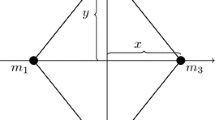Appendix
1.1 7.1 Matrices of the linearization
where \(\tilde{e}_{ii}=\frac{1}{\rho_{i}^{2}} (2p_{\rho_{i}}p_{ \theta_{i}}+2 p_{\theta_{i}}+U^{i}_{\rho_{i}\theta_{i}}-\frac{2U^{i} _{\theta_{i}}}{\rho_{i}} )\) for \(i=1,\dots ,4\).
1.2 7.2 Partial derivatives of the potential \(U_{j}\)
The second partial derivatives of \(U_{j}\) evaluated at a rhomboidal configuration are such that
$$\begin{aligned} &\!\begin{aligned}[b] \frac{\partial^{2}U_{1}}{\partial \rho^{2}_{1}}&= \frac{\partial^{2}U _{2}}{\partial \rho^{2}_{2}} \\ &= \frac{m}{4 \lambda^{3}} + \frac{2 (m + m _{0})}{\lambda^{3}} + \frac{6 \lambda^{2} \tilde{m}}{(\lambda^{2}+ 1)^{5/2}} - \frac{2 \tilde{m}}{(\lambda^{2} + 1)^{3/2}}, \end{aligned} \end{aligned}$$
(38)
$$\begin{aligned} & \frac{\partial^{2}U_{1}}{\partial \rho_{1} \partial \rho_{2}}= \frac{ \partial^{2}U_{2}}{\partial \rho_{2} \partial \rho_{1}}= -\frac{7 m}{4 \lambda^{3}}, \end{aligned}$$
(39)
$$\begin{aligned} &\!\begin{aligned}[b] \frac{\partial^{2}U_{1}}{\partial \rho_{1} \partial \rho_{3}} &= \frac{ \partial^{2}U_{1}}{\partial \rho_{1} \partial \rho_{4}}= \frac{ \partial^{2}U_{2}}{\partial \rho_{2} \partial \rho_{3}}= \frac{ \partial^{2}U_{2}}{\partial \rho_{2} \partial \rho_{4}}= \frac{ \partial^{2}U_{3}}{\partial \rho_{3} \partial \rho_{1}} \\ &= \frac{\partial^{2}U_{3}}{\partial \rho_{3} \partial \rho_{2}}=\frac{ \partial^{2}U_{4}}{\partial \rho_{4} \partial \rho_{1}}= \frac{ \partial^{2}U_{4}}{\partial \rho_{4} \partial \rho_{2}} = \frac{3 \lambda \tilde{m}}{(\lambda^{2} + 1)^{5/2}}, \end{aligned} \end{aligned}$$
(40)
$$\begin{aligned} &\!\begin{aligned}[b] \frac{\partial^{2}U_{3}}{\partial \rho^{2}_{3}} &= \frac{\partial^{2}U _{4}}{\partial \rho^{2}_{4}} \\ &= \frac{6 m}{(\lambda^{2} + 1)^{5/2}} - \frac{2 m}{(\lambda^{2} + 1)^{3/2}} + \frac{\tilde{m}}{4} + 2(m_{0} + \tilde{m}), \end{aligned} \end{aligned}$$
(41)
$$\begin{aligned} & \frac{\partial^{2}U_{3}}{\partial \rho_{3} \partial \rho_{4}}= \frac{ \partial^{2}U_{4}}{\partial \rho_{4} \partial \rho_{3}}= -\frac{7 \tilde{m}}{4}, \end{aligned}$$
(42)
$$\begin{aligned} & \frac{\partial^{2}U_{1}}{\partial \theta_{1} \partial \rho_{1}}= \frac{ \partial^{2}U_{1}}{\partial \theta_{1} \partial \rho_{2}}= \frac{ \partial^{2}U_{2}}{\partial \theta_{2} \partial \rho_{1}}= \frac{ \partial^{2}U_{2}}{\partial \theta_{2} \partial \rho_{2}}=\frac{ \partial^{2}U_{3}}{\partial \theta_{3} \partial \rho_{3}}= 0, \end{aligned}$$
(43)
$$\begin{aligned} & \frac{\partial^{2}U_{1}}{\partial \rho_{1} \partial \theta_{1}} =\frac{ \partial^{2}U_{1}}{\partial \rho_{1} \partial \theta_{2}}=0, \end{aligned}$$
(44)
$$\begin{aligned} & \frac{\partial^{2}U_{1}}{\partial \rho_{1} \partial \theta_{3}}= -\frac{ \partial^{2}U_{1}}{\partial \rho_{1} \partial \theta_{4}}= \tilde{m} \biggl( 1+ \frac{2\lambda^{2}-1}{(\lambda^{2}+1)^{5/2}} \biggr) , \end{aligned}$$
(45)
$$\begin{aligned} &\!\begin{aligned}[b] \frac{\partial^{2}U_{1}}{\partial \theta_{1} \partial \rho_{3}} &= -\frac{ \partial^{2}U_{1}}{\partial \theta_{1} \partial \rho_{4}}= - \frac{ \partial^{2}U_{2}}{\partial \theta_{2} \partial \rho_{3}} \\ &= -\frac{\partial^{2}U_{3}}{\partial \theta_{3} \partial \rho_{1}}=-\frac{ \partial^{2}U_{3}}{\partial \theta_{3} \partial \rho_{2}}= -\frac{ \partial^{2}U_{3}}{\partial \theta_{4} \partial \rho_{1}} \\ &= \biggl( 2 - \frac{3 }{(\lambda^{2} + 1)^{5/2}} + \frac{1}{(\lambda ^{2} + 1)^{3/2}} \biggr) \lambda \tilde{m}, \end{aligned} \end{aligned}$$
(46)
$$\begin{aligned} & \frac{\partial^{2}U_{2}}{\partial \rho_{2} \partial \theta_{3}}= -\frac{ \partial^{2}U_{2}}{\partial \rho_{2} \partial \theta_{4}}= \biggl( -1+ \frac{2\lambda^{2}- 1}{(\lambda^{2} + 1)^{5/2}} \biggr) \tilde{m}, \end{aligned}$$
(47)
$$\begin{aligned} & \frac{\partial^{2}U_{3}}{\partial \rho_{3} \partial \theta_{1}}= \biggl( \frac{-2}{\lambda^{3}} + \frac{(\lambda^{2} - 2 )}{(\lambda^{2} + 1)^{5/2}} \biggr) \lambda m, \end{aligned}$$
(48)
$$\begin{aligned} & \frac{\partial^{2}U_{3}}{\partial \rho_{3} \partial \theta_{2}}= -\frac{ \lambda m (\lambda^{2} - 2 ) }{(\lambda^{2} + 1)^{5/2}}, \end{aligned}$$
(49)
$$\begin{aligned} & \frac{\partial^{2}U_{3}}{\partial \rho_{3} \partial \theta_{3}}= \frac{2 m}{\lambda^{2}}, \end{aligned}$$
(50)
$$\begin{aligned} & \frac{\partial^{2}U_{3}}{\partial \rho_{3} \partial \theta_{4}}= \frac{ \partial^{2}U_{4}}{\partial \rho_{4} \partial \theta_{3}}=\frac{ \partial^{2}U_{4}}{\partial \rho_{4} \partial \theta_{4}}= 0, \end{aligned}$$
(51)
$$\begin{aligned} & \frac{\partial^{2}U_{4}}{\partial \rho_{4} \partial \theta_{1}}= -\frac{ \partial^{2}U_{4}}{\partial \rho_{4} \partial \theta_{2}}= \biggl( \frac{1}{ \lambda^{3}} + \frac{(-\lambda^{2} + 2 )}{(\lambda^{2} + 1)^{5/2}} \biggr) \lambda m, \end{aligned}$$
(52)
$$\begin{aligned} & \frac{\partial^{2}U_{1}}{\partial z^{2}_{1}}= \frac{\partial^{2}U _{2}}{\partial z^{2}_{2}}= - \frac{9 m + 8m_{0}}{8\lambda^{3}} - \frac{2 \tilde{m}}{(\lambda^{2} + 1)^{3/2}}, \end{aligned}$$
(53)
$$\begin{aligned} & \frac{\partial^{2}U_{1}}{\partial z_{1} \partial z_{2}}= \frac{ \partial^{2}U_{2}}{\partial z_{2} \partial z_{1}}= -\frac{7 m}{8 \lambda^{3}}, \end{aligned}$$
(54)
$$\begin{aligned} &\!\begin{aligned}[b] \frac{\partial^{2}U_{1}}{\partial z_{1} \partial z_{3}} &= \frac{ \partial^{2}U_{1}}{\partial z_{1} \partial z_{4}}= \frac{\partial^{2}U _{2}}{\partial z_{2} \partial z_{3}} \\ &=\frac{\partial^{2}U_{2}}{\partial z_{2} \partial z_{4}}= \biggl( \frac{1}{( \lambda^{2} + 1)^{3/2}} - 1 \biggr) \tilde{m}, \end{aligned} \end{aligned}$$
(55)
$$\begin{aligned} &\!\begin{aligned}[b] \frac{\partial^{2}U_{3}}{\partial z_{3} \partial z_{1}} &= \frac{ \partial^{2}U_{3}}{\partial z_{3} \partial z_{2}} = \frac{\partial^{2}U _{4}}{\partial z_{4} \partial z_{1}} \\ & =\frac{\partial^{2}U_{4}}{\partial z_{4} \partial z_{2}}= \biggl( \frac{1}{( \lambda^{2} + 1)^{3/2}} - \frac{1}{\lambda^{3}} \biggr) m, \end{aligned} \end{aligned}$$
(56)
$$\begin{aligned} & \frac{\partial^{2}U_{3}}{\partial z^{2}_{3}}= \frac{\partial^{2}U _{4}}{\partial z^{2}_{4}}= -\frac{2 m}{(\lambda^{2} + 1)^{3/2}} - \frac{9 \tilde{m}}{8} -m_{0}, \end{aligned}$$
(57)
$$\begin{aligned} & \frac{\partial^{2}U_{3}}{\partial z_{3} \partial z_{4}}= \frac{ \partial^{2}U_{4}}{\partial z_{4} \partial z_{3}}= - \frac{7 \tilde{m}}{8}, \end{aligned}$$
(58)
$$\begin{aligned} & \frac{\partial^{2}U_{4}}{\partial \rho_{4} \partial \theta_{3}}= \frac{ \partial^{2}U_{4}}{\partial \rho_{4} \partial \theta_{4}}= 0, \end{aligned}$$
(59)
$$\begin{aligned} & \frac{\partial^{2}U_{1}}{\partial \rho_{1} \partial z_{1}}= \frac{ \partial^{2}U_{1}}{\partial \rho_{1} \partial z_{2}}= \frac{\partial ^{2}U_{1}}{\partial \rho_{1} \partial z_{3}}=\frac{\partial^{2}U_{1}}{ \partial \rho_{1} \partial z_{4}}= 0, \end{aligned}$$
(60)
$$\begin{aligned} & \frac{\partial^{2}U_{2}}{\partial \rho_{2} \partial z_{1}}= \frac{ \partial^{2}U_{2}}{\partial \rho_{2} \partial z_{2}}= \frac{\partial ^{2}U_{2}}{\partial \rho_{2} \partial z_{3}}=\frac{\partial^{2}U_{2}}{ \partial \rho_{2} \partial z_{4}}= 0, \end{aligned}$$
(61)
$$\begin{aligned} & \frac{\partial^{2}U_{3}}{\partial \rho_{3} \partial z_{1}}= \frac{ \partial^{2}U_{3}}{\partial \rho_{3} \partial z_{2}}= \frac{\partial ^{2}U_{3}}{\partial \rho_{3} \partial z_{3}}=\frac{\partial^{2}U_{3}}{ \partial \rho_{3} \partial z_{4}}= 0, \end{aligned}$$
(62)
$$\begin{aligned} & \frac{\partial^{2}U_{4}}{\partial \rho_{4} \partial z_{1}}= \frac{ \partial^{2}U_{4}}{\partial \rho_{4} \partial z_{2}}= \frac{\partial ^{2}U_{4}}{\partial \rho_{4} \partial z_{3}}= \frac{\partial^{2}U_{4}}{ \partial \rho_{4} \partial z_{4}}= 0, \end{aligned}$$
(63)
$$\begin{aligned} & \frac{\partial^{2}U_{2}}{\partial z_{2} \partial \theta_{1}}= \frac{ \partial^{2}U_{2}}{\partial z_{2} \partial \theta_{2}}= \frac{\partial ^{2}U_{2}}{\partial z_{2} \partial \theta_{3}}= \frac{\partial^{2}U _{2}}{\partial z_{2} \partial \theta_{4}}= 0, \end{aligned}$$
(64)
$$\begin{aligned} & \frac{\partial^{2}U_{3}}{\partial z_{3} \partial \theta_{1}}= \frac{ \partial^{2}U_{3}}{\partial z_{3} \partial \theta_{2}}= \frac{\partial ^{2}U_{3}}{\partial z_{3} \partial \theta_{3}}= \frac{\partial^{2}U _{3}}{\partial z_{3} \partial \theta_{4}}= 0, \end{aligned}$$
(65)
$$\begin{aligned} & \frac{\partial^{2}U_{4}}{\partial z_{4} \partial \theta_{1}}= \frac{ \partial^{2}U_{4}}{\partial z_{4} \partial \theta_{2}}= \frac{\partial ^{2}U_{4}}{\partial z_{4} \partial \theta_{3}}= \frac{\partial^{2}U _{4}}{\partial z_{4} \partial \theta_{4}}= 0, \end{aligned}$$
(66)
$$\begin{aligned} & \frac{\partial^{2}U_{1}}{\partial \theta^{2}_{1}}= \frac{\partial ^{2}U_{2}}{\partial \theta^{2}_{2}} = -\frac{7 m}{8\lambda }+ \frac{6 \lambda^{2} \tilde{m}}{(\lambda^{2}+1)^{5/2}}, \end{aligned}$$
(67)
$$\begin{aligned} & \frac{\partial^{2}U_{1}}{\partial \theta_{1} \partial \theta_{2}}= \frac{ \partial^{2}U_{2}}{\partial \theta_{2} \partial \theta_{1}}= \frac{7m}{8 \lambda }, \end{aligned}$$
(68)
$$\begin{aligned} &\!\begin{aligned}[b] \frac{\partial^{2}U_{1}}{\partial \theta_{1} \partial \theta_{3}} &= \frac{ \partial^{2}U_{1}}{\partial \theta_{1} \partial \theta_{4}}= \frac{ \partial^{2}U_{2}}{\partial \theta_{2} \partial \theta_{3}} \\ &= \frac{\partial^{2}U_{2}}{\partial \theta_{2} \partial \theta_{4}}= -\frac{3 \lambda^{2} \tilde{m}}{(\lambda^{2}+1)^{3/2}}, \end{aligned} \end{aligned}$$
(69)
$$\begin{aligned} & \frac{\partial^{2}U_{3}}{\partial \theta^{2}_{3}}= \frac{\partial ^{2}U_{4}}{\partial \theta^{2}_{4}} = -\frac{7}{8} \tilde{m}+ \frac{6 \lambda^{2} m}{(\lambda^{2}+1)^{5/2}}, \end{aligned}$$
(70)
$$\begin{aligned} &\!\begin{aligned}[b] \frac{\partial^{2}U_{3}}{\partial \theta_{3} \partial \theta_{1}} &= \frac{ \partial^{2}U_{3}}{\partial \theta_{3} \partial \theta_{2}}= \frac{ \partial^{2}U_{4}}{\partial \theta_{4} \partial \theta_{1}} \\ &= \frac{\partial^{2}U_{4}}{\partial \theta_{4} \partial \theta_{2}}= -\frac{3 \lambda^{2} m}{(\lambda^{2}+1)^{3/2}}, \end{aligned} \end{aligned}$$
(71)
$$\begin{aligned} & \frac{\partial^{2}U_{3}}{\partial \theta_{3} \partial \theta_{4}}= \frac{ \partial^{2}U_{4}}{\partial \theta_{4} \partial \theta_{3}}= \frac{7 \tilde{m}}{8}. \end{aligned}$$
(72)








